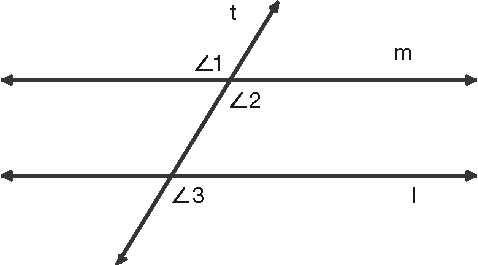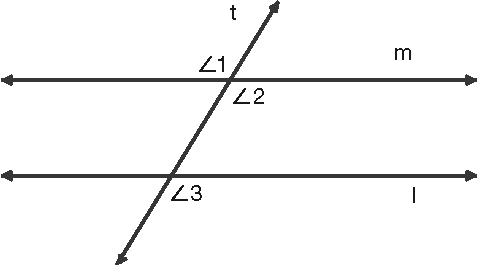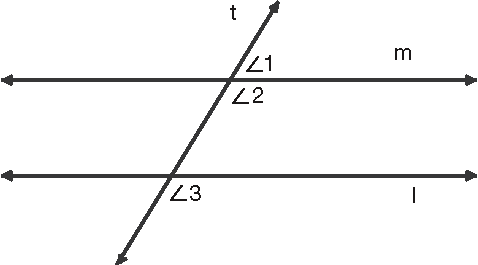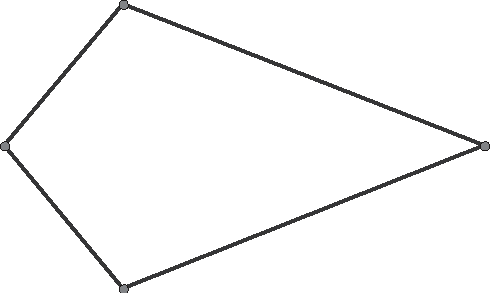Geometry: Answer Key
Answer Key
This provides the answers and solutions for the Put Me in, Coach! exercise boxes, organized by sections.
Taking the Burden out of Proofs
- Yes
- Theorem 8.3: If two angles are complementary to the same angle, then these two angles are congruent.

∠A and ∠B are complementary, and ∠C and ∠B are complementary.
Given: ∠A and ∠B are complementary, and ∠C and ∠B are complementary.
Prove: ∠A ~= ∠C.
| Statements | Reasons | |
|---|---|---|
| 1. | ∠A and ∠B are complementary, and ∠C and ∠B are complementary. | Given |
| 2. | m∠A + m∠B = 90º , m∠C + m∠B = 90º | Definition of complementary |
| 3. | m∠A = 90 º - m∠B, m∠C = 90º - m∠B | Subtraction property of equality |
| 4. | m∠A = m∠C | Substitution (step 3) |
| 5. | ∠A ~= ∠C | Definition of ~= |
Proving Segment and Angle Relationships
- If E is between D and F, then DE = DF − EF.

E is between D and F.
Given: E is between D and F
Prove: DE = DF − EF.
| Statements | Reasons | |
|---|---|---|
| 1. | E is between D and F | Given |
| 2. | D, E, and F are collinear points, and E is on ¯DF | Definition of between |
| 3. | DE + EF = DF | Segment Addition Postulate |
| 4. | DE = DF − EF | Subtraction property of equality |
2. If →BD divides ∠ABC into two angles, ∠ABD and ∠DBC, then m∠ABC = m∠ABC - m∠DBC.

→BD divides ∠ABC into two angles, ∠ABD and ∠DBC.
Given: →BD divides ∠ABC into two angles, ∠ABD and ∠DBC
Prove: m∠ABD = m∠ABC - m∠DBC.
| Statements | Reasons | |
|---|---|---|
| 1. | →BD divides ∠ABC into two angles, ∠ABD and ∠DBC | Given |
| 2. | m∠ABD + m∠DBC = m∠ABC | Angle Addition Postulate |
| 3. | m∠ABD = m∠ABC - m∠DBC | Subtraction property of equality |
3. The angle bisector of an angle is unique.

∠ABC with two angle bisectors: →BD and →BE.
Given: ∠ABC with two angle bisectors: →BD and →BE.
Prove: m∠DBC = 0.
| Statements | Reasons | |
|---|---|---|
| 1. | →BD and →BE bisect ∠ABC | Given |
| 2. | ∠ABC ~= ∠DBC and ∠ABE ~= ∠EBC | Definition of angel bisector |
| 3. | m∠ABD = m∠DBC and m∠ABE ~= m∠EBC | Definition of ~= |
| 4. | m∠ABD + m∠DBE + m∠EBC = m∠ABC | Angle Addition Postulate |
| 5. | m∠ABD + m∠DBC = m∠ABC and m∠ABE + m∠EBC = m∠ABC | Angle Addition Postulate |
| 6. | 2m∠ABD = m∠ABC and 2m∠EBC = m∠ABC | Substitution (steps 3 and 5) |
| 7. | m∠ABD = m∠ABC/2 and m∠EBC = m∠ABC/2 | Algebra |
| 8. | m∠ABC/2 + m∠DBE + m∠ABC/2 = m∠ABC | Substitution (steps 4 and 7) |
| 9. | m∠ABC + m∠DBE = m∠ABC | Algebra |
| 10. | m∠DBE = 0 | Subtraction property of equality |
4. The supplement of a right angle is a right angle.

∠A and ∠B are supplementary angles, and ∠A is a right angle.
Given: ∠A and ∠B are supplementary angles, and ∠A is a right angle.
Prove: ∠B is a right angle.
| Statements | Reasons | |
|---|---|---|
| 1. | ∠A and ∠B are supplementary angles, and ∠A is a right angle | Given |
| 2. | m∠A + m∠B = 180º | Definition of supplementary angles |
| 3. | m∠A = 90º | Definition of right angle |
| 4. | 90º + m∠B = 180º | Substitution (steps 2 and 3) |
| 5. | m∠B = 90º | Algebra |
| 6. | ∠B is a right angle | Definition of right angle |
Proving Relationships Between Lines
- m∠6 = 105º , m∠8 = 75º
- Theorem 10.3: If two parallel lines are cut by a transversal, then the alternate exterior angles are congruent.

l m cut by a transversal t.
Given: l m cut by a transversal t.
Prove: ∠1 ~= ∠3.
| Statements | Reasons | |
|---|---|---|
| 1. | l m cut by a transversal t | Given |
| 2. | ∠1 and ∠2 are vertical angles | Definition of vertical angles |
| 3. | ∠2 and ∠3 are corresponding angles | Definition of corresponding angles |
| 4. | ∠2 ~= ∠3 | Postulate 10.1 |
| 5. | ∠1 ~= ∠2 | Theorem 8.1 |
| 6. | ∠1 ~= ∠3 | Transitive property of 3. |
3. Theorem 10.5: If two parallel lines are cut by a transversal, then the exterior angles on the same side of the transversal are supplementary angles.

l m cut by a transversal t.
Given: l m cut by a transversal t.
Prove: ∠1 and ∠3 are supplementary.
| Statement | Reasons | |
|---|---|---|
| 1. | l m cut by a transversal t | Given |
| 2. | ∠1 and ∠2 are supplementary angles, and m∠1 + m∠2 = 180º | Definition of supplementary angles |
| 3. | ∠2 and ∠3 are corresponding angles | Definition of corresponding angles |
| 4. | ∠2 ~= ∠3 | Postulate 10.1 |
| 5. | m∠2 ~= m∠3 | Definition of ~= |
| 6. | m∠1 + m∠3 = 180º | Substitution (steps 2 and 5) |
| 7. | ∠1 and ∠3 are supplementary | Definition of supplementary |
4. Theorem 10.9: If two lines are cut by a transversal so that the alternate exterior angles are congruent, then these lines are parallel.

Lines l and m are cut by a transversal t.
Given: Lines l and m are cut by a transversal t, with ∠1 ~= ∠3.
Prove: l m.
| Statement | Reasons | |
|---|---|---|
| 1. | Lines l and m are cut by a transversal t, with ∠1 ~= ∠3 | Given |
| 2. | ∠1 and ∠2 are vertical angles | Definition of vertical angles |
| 3. | ∠1 ~= ∠2 | Theorem 8.1 |
| 4. | ∠2 ~= ∠3 | Transitive property of ~=. |
| 5. | ∠2 and ∠3 are corresponding angles | Definition of corresponding angles |
| 6. | l m | Theorem 10.7 |
5. Theorem 10.11: If two lines are cut by a transversal so that the exterior angles on the same side of the transversal are supplementary, then these lines are parallel.

Lines l and m are cut by a t transversal t.
Given: Lines l and m are cut by a transversal t, ∠1 and ∠3 are supplementary angles.
Prove: l m.
| Statement | Reasons | |
|---|---|---|
| 1. | Lines l and m are cut by a transversal t, and ∠1 are ∠3 supplementary angles | Given |
| 2. | ∠2 and ∠1 are supplementary angles | Definition of supplementary angles |
| 3. | ∠3 ~= ∠2 | Example 2 |
| 4. | ∠3 and ∠2 are corresponding angles | Definition of corresponding angles |
| 5. | l m | Theorem 10.7 |
Two's Company. Three's a Triangle
- An isosceles obtuse triangle
- The acute angles of a right triangle are complementary.

ΔABC is a right triangle.
Given: ΔABC is a right triangle, and ∠B is a right angle.
Prove: ∠A and ∠C are complementary angles.
| Statement | Reasons | |
|---|---|---|
| 1. | ΔABC is a right triangle, and ∠B is a right angle | Given |
| 2. | m∠B = 90º | Definition of right angle |
| 3. | m∠A + m∠B + m∠C = 180º | Theorem 11.1 |
| 4. | m∠A + 90º + m∠C = 180º | Substitution (steps 2 and 3) |
| 5. | m∠A + m∠C = 90º | Algebra |
| 6. | ∠A and ∠C are complementary angles | Definition of complementary angles |
3. Theorem 11.3: The measure of an exterior angle of a triangle equals the sum of the measures of the two nonadjacent interior angles.

ΔABC with exterior angle ∠BCD.
| Statement | Reasons | |
|---|---|---|
| 1. | ΔABC with exterior angle ∠BCD | Given |
| 2. | ∠DCA is a straight angle, and m∠DCA = 180º | Definition of straight angle |
| 3. | m∠BCA + m∠BCD = m∠DCA | Angle Addition Postulate |
| 4. | m∠BCA + m∠BCD = 180º | Substitution (steps 2 and 3) |
| 5. | m∠BAC + m∠ABC + m∠BCA = 180º | Theorem 11.1 |
| 6. | m∠BAC + m∠ABC + m∠BCA = m∠BCA + m∠BCD | Substitution (steps 4 and 5) |
| 7. | m∠BAC + m∠ABC = m∠BCD | Subtraction property of equality |
4. 12 units2
5. 30 units2
6. No, a triangle with these side lengths would violate the triangle inequality.
Congruent Triangles
1. Reflexive property: ΔABC ~= ΔABC.
Symmetric property: If ΔABC ~= ΔDEF, then ΔDEF ~= ΔABC.
Transitive property: If ΔABC ~= ΔDEF and ΔDEF ~= ΔRST, then ΔABC ~= ΔRST.
2. Proof: If ¯AC ~= ¯CD and ∠ACB ~= ∠DCB as shown in Figure 12.5, then ΔACB ~= ΔDCB.
| Statement | Reasons | |
|---|---|---|
| 1. | ¯AC ~= ¯CD and ∠ACB ~= ∠DCB | Given |
| 2. | ¯BC ~= ¯BC | Reflexive property of ~= |
| 3. | ΔACB ~= ΔDCB | SAS Postulate |
3. If ¯CB ⊥ ¯AD and ∠ACB ~= ∠DCB, as shown in Figure 12.8, then ΔACB ~= ΔDCB.
| Statement | Reasons | |
|---|---|---|
| 1. | ¯CB ⊥ ¯AD and ∠ACB ~= ∠DCB | Given |
| 2. | ∠ABC and ∠DBC are right angles | Definition of ⊥ |
| 3. | m∠ABC = 90º and m∠DBC = 90º | Definition of right angles |
| 4. | m∠ABC = m∠DBC | Substitution (step 3) |
| 5. | ∠ABC ~= ∠DBC | Definition of ~= |
| 6. | ¯BC ~= ¯BC | Reflexive property of ~= |
| 7. | ΔACB ~= ΔDCB | ASA Postulate |
4. If ¯CB ⊥ ¯AD and ∠CAB ~= ∠CDB, as shown in Figure 12.10, then ΔACB~= ΔDCB.
| Statement | Reasons | |
|---|---|---|
| 1. | ¯CB ⊥ ¯AD and ∠CAB ~= ∠CDB | Given |
| 2. | ∠ABC and ∠DBC are right angles | Definition of ⊥ |
| 3. | m∠ABC = 90º and m∠DBC = 90º | Definition of right angles |
| 4. | m∠ABC = m∠DBC | Substitution (step 3) |
| 5. | ∠ABC ~= ∠DBC | Definition of ~= |
| 6. | ¯BC ~= ¯BC | Reflexive property of ~= |
| 7. | ΔACB ~= ΔDCB | AAS Theorem |
5. If ¯CB ⊥ ¯AD and ¯AC ~= ¯CD, as shown in Figure 12.12, then ΔACB ~= ΔDCB.
| Statement | Reasons | |
|---|---|---|
| 1. | ¯CB ⊥ ¯AD and ¯AC ~= ¯CD | Given |
| 2. | ΔABC and ΔDBC are right triangles | Definition of right triangle |
| 3. | ¯BC ~= ¯BC | Reflexive property of ~= |
| 4. | ΔACB ~= ΔDCB | HL Theorem for right triangles |
6. If ∠P ~= ∠R and M is the midpoint of ¯PR, as shown in Figure 12.17, then ∠N ~= ∠Q.
| Statement | Reasons | |
|---|---|---|
| 1. | ∠P ~= ∠R and M is the midpoint of ¯PR | Given |
| 2. | ¯PM ~= ¯MR | Definition of midpoint |
| 3. | ∠NMP and ∠RMQ are vertical angles | Definition of vertical angles |
| 4. | ∠NMP ~= ∠RMQ | Theorem 8.1 |
| 5. | ΔPMN ~= RMQ | ASA Postulate |
| 6. | ∠N ~= ∠Q | CPOCTAC |
Smiliar Triangles
- x = 11
- x = 12
- 40º and 140º
- If ∠A ~= ∠D as shown in Figure 13.6, then BC/AB = CE/DE.
| Statement | Reasons | |
|---|---|---|
| 1. | ∠A ~= ∠D | Given |
| 2. | ∠BCA and ∠DCE are vertical angles | Definition of vertical angles |
| 3. | ∠BCA ~= ∠DCE | Theorem 8.1 |
| 4. | ΔACB ~ ΔDCE | AA Similarity Theorem |
| 5. | BC/AB = CE/DE | CSSTAP |
5. 150 feet.
Opening Doors with Similar Triangles
- If a line is parallel to one side of a triangle and passes through the midpoint of a second side, then it will pass through the midpoint of the third side.

¯DE ¯AC and D is the midpoint of ¯AB.
Given: ¯DE ¯AC and D is the midpoint of ¯AB.
Prove: E is the midpoint of ¯BC.
| Statement | Reasons | |
|---|---|---|
| 1. | ¯DE ¯AC and D is the midpoint of ¯AB. | Given |
| 2. | ¯DE ¯AC and is cut by transversal ↔AB | Definition of transversal |
| 3. | ∠BDE and ∠BAC are corresponding angles | Definition of corresponding angles |
| 4. | ∠BDE ~= ∠BAC | Postulate 10.1 |
| 5. | ∠B ~= ∠B | Reflexive property of ~= |
| 6. | ΔABC ~ ΔDBE | AA Similarity Theorem |
| 7. | DB/AB = BE/BC | CSSTAP |
| 8. | DB = AB/2 | Theorem 9.1 |
| 9. | DB/AB = 1/2 | Algebra |
| 10. | 1/2 = BE/BC | Substitution (steps 7 and 9) |
| 11. | BC = 2BE | Algebra |
| 12. | BE + EC = BC | Segment Addition Postulate |
| 13. | BE + EC = 2BE | Substitution (steps 11 and 12) |
| 14. | EC = BE | Algebra |
| 15. | E is the midpoint of ¯BC | Definition of midpoint |
2. AC = 4√3 , AB = 8√ , RS = 16, RT = 8√3
3. AC = 4√2 , BC = 4√2
Putting Quadrilaterals in the Forefront
- AD = 63, BC = 27, RS = 45
- ¯AX, ¯CZ, and ¯DY

Trapezoid ABCD with its XB CY four altitudes shown.
3. Theorem 15.5: In a kite, one pair of opposite angles is congruent.

Kite ABCD.
Given: Kite ABCD.
Prove: ∠B ~= ∠D.
| Statement | Reasons | |
|---|---|---|
| 1. | ABCD is a kite | Given |
| 2. | ¯AB ~= ¯AD and ¯BC ~= ¯DC | Definition of a kite |
| 3. | ¯AC ~= ¯AC | Reflexive property of ~= |
| 4. | ΔABC ~= ΔADC | SSS Postulate |
| 5. | ∠B ~= ∠D | CPOCTAC |
4. Theorem 15.6: The diagonals of a kite are perpendicular, and the diagonal opposite the congruent angles bisects the other diagonal.

Kite ABCD.
Given: Kite ABCD.
Prove: ¯BD ⊥ ¯AC and ¯BM ~= ¯MD.
| Statement | Reasons | |
|---|---|---|
| 1. | ABCD is a kite | Given |
| 2. | ¯AB ~= ¯AD and ¯BC ~= ¯DC | Definition of a kite |
| 3. | ¯AC ~= ¯AC | Reflexive property of ~= |
| 4. | ΔABC ~= ΔADC | SSS Postulate |
| 5. | ∠BAC ~= ∠DAC | CPOCTAC |
| 6. | ¯AM ~= ¯AM | Reflexive property of ~= |
| 7. | ΔABM ~= ΔADM | SAS Postulate |
| 8. | ¯BM ~= ¯MD | CPOCTAC |
| 9. | ∠BMA ~= ∠DMA | CPOCTAC |
| 10. | m∠BMA = m∠DMA | Definition of ~= |
| 11. | ∠MBD is a straight angle, and m∠BMD = 180º | Definition of straight angle |
| 12. | m∠BMA + m∠DMA = m∠BMD | Angle Addition Postulate |
| 13. | m∠BMA + m∠DMA = 180º | Substitution (steps 9 and 10) |
| 14. | 2m∠BMA = 180º | Substitution (steps 9 and 12) |
| 15. | m∠BMA = 90º | Algebra |
| 16. | ∠BMA is a right angle | Definition of right angle |
| 17. | ¯BD ⊥ ¯AC | Definition of ⊥ |
5. Theorem 15.9: Opposite angles of a parallelogram are congruent.

Parallelogram ABCD.
Given: Parallelogram ABCD.
Prove: ∠ABC ~= ∠ADC.
| Statement | Reasons | |
|---|---|---|
| 1. | Parallelogram ABCD has diagonal ¯AC. | Given |
| 2. | ΔABC ~= ΔCDA | Theorem 15.7 |
| 3. | ∠ABC ~= ∠ADC | CPOCTAC |
6. 144 units2
7. 180 units2
8. Kite ABCD has area 48 units2.
Parallelogram ABCD has area 150 units2.
Rectangle ABCD has area 104 units2.
Rhombus ABCD has area 35/2 units2.
Anatomy of a Circle
- Circumference: 20π feet, length of ˆRST = 155/18π feet
- 9π feet2
- 15π feet2
- 28º
The Unit Circle and Trigonometry
- 3/√34 = 3√34/34
- 1/√3 = √3/3
- tangent ratio = √40/3, sine ratio = √40/7
- tangent ratio = 5/√56 = 5√56/56, cosine ratio = √56/9
Excerpted from The Complete Idiot's Guide to Geometry © 2004 by Denise Szecsei, Ph.D.. All rights reserved including the right of reproduction in whole or in part in any form. Used by arrangement with Alpha Books, a member of Penguin Group (USA) Inc.
To order this book direct from the publisher, visit the Penguin USA website or call 1-800-253-6476. You can also purchase this book at Amazon.com and Barnes & Noble.








